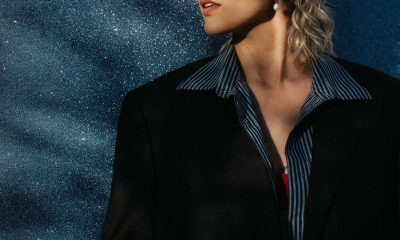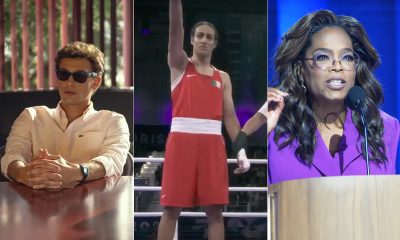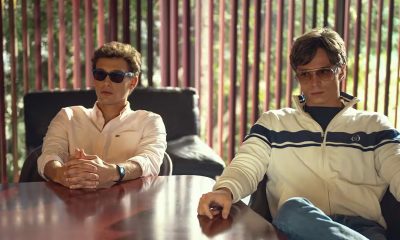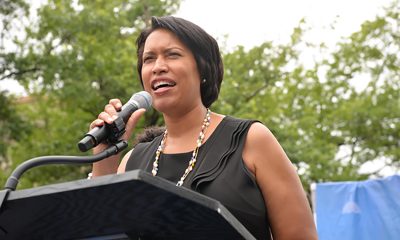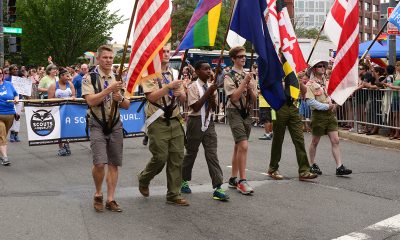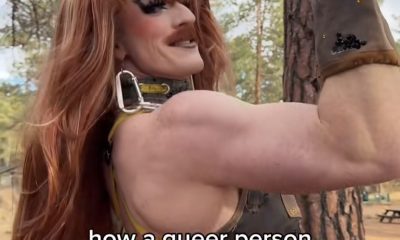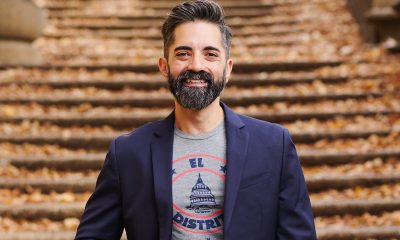Arts & Entertainment
Portal to the past
Legendary photographer Leibovitz unveils new Smithsonian history-inspired show
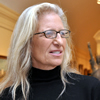
‘Annie Leibovitz: Pilgrimage’
Smithsonian American Museum of Art
8th and F Street, NW
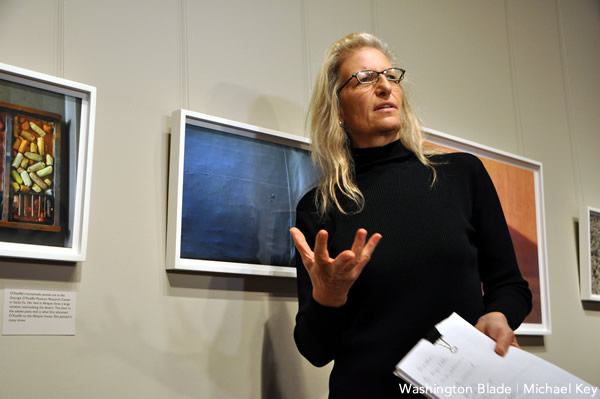
Annie Leibovitz in Washington Tuesday guiding a press tour of her new Smithsonian exhibit 'Pilgrimage.' (Blade photo by Michael Key)
Throughout her 40-year career, renowned American photographer Annie Leibovitz has remained a constant on the celebrity portraiture scene photographing everyone from Mick Jagger to her late lover author Susan Sontag to Miley Cyrus. In many instances her creative, nontraditional approach to making portraits has raised Leibovitz’s already celebrated subjects to cultural icon status (think a naked-and-very-pregnant Demi Moore on the cover of Vanity Fair).
But despite fabulous commercial and artistic success, Leibovitz, 62, went through a very public financial rough patch in recent years. It was during this time of duress that she opted to take a step back and pursue an unassigned, more personal project. In the tradition of great photographers like Walker Evans and Robert Frank, Leibovitz hit the road looking for inspiration and sources of renewal. In her travels, she was drawn to storied locales including Elvis’ Graceland and Georgia O’Keefe’s New Mexico studio, and people of historical significance like Annie Oakley and Martha Graham — stars from the past. And though she didn’t photograph any people for the project, she did shoot objects, landscapes and interiors connected to their lives and memories.
The result of her almost exclusively cross country odyssey (there was a brief trip to London) is “Pilgrimage” the book, as well as “Annie Leibovitz: Pilgrimage,” a photographic exhibition of 64 gorgeous and intriguing photos taken between April 2009 and May 2011 that currently fills three rooms on the second floor of the Smithsonian American Art Museum. It’s up through May 20.
At a Tuesday press event, an amiable and forthcoming Leibovitz (tall and trim in black turtleneck, black pants and hiking boots) leads a group of press types through the exhibition. Going into the project, Leibovitz didn’t quite know what was going to happen, but that’s when the magic happens, she says. An interest in the Lincoln Memorial became a broader investigation into Gettysburg, Lincoln’s boyhood homes and African-American contralto Miriam Anderson who famously sang on the steps of the Memorial in 1939 after being denied the right to perform at segregated Constitution Hall. The exhibition includes a haunting photo of one of Anderson’s gowns from the era.
Similarly, when the New York-based Leibovitz traveled to Concord, Mass., to check out Walden Pond and Henry David Thoreau, she discovered Ralph Waldo Emerson’s library and novelist Louisa May Alcott’s carefully preserved home. In Amherst, Leibovitz dove into the life of Emily Dickinson (a Sontag favorite). The exhibit includes a tight shot of one of Dickinson’s surviving dresses. Contrary to what’s been said, the poet did not spend her last years roaming the house-shrouded specter. In fact, her garment of choice was an ornately embroidered white nightgown with alabaster buttons.
The project took Leibovitz west to shoot Annie Oakley’s riding boots and a bullet pierced heart-shaped target from the cowgirl’s Wild West Show. In England, Leibovitz made beautiful photos of Freud’s couch and the surface of Virginia Woolf’s grubby, ink-stained writing desk. And closer to home, she shot a peek into Val-Kill, Eleanor Roosevelt’s modest girls-only retreat in the Hudson Valley.
“Pilgrimage” is Leibovitz’ first all-digital show, and though she professes a keen interest in new methods of photography (“You’ve got to keep up.”), she likes to keep things looking real. Her photos are stylized, abstract and literal. Some shots (including an overhead look at Thoreau’s bed), she describes as more documents than photographs.
While she’d hoped for the book, Leibovitz didn’t expect “Pilgrimage” to be shown at the Smithsonian.
“It’s wonderful. These rooms are brimming with history. They could actually be photographed as part of the exhibition,” she says. “When I first came here I noticed the number of school children touring the gallery so I intentionally hung the show especially low and crowded the rooms with lots of photos and information — something the exhibition’s curator [Andy Grundberg ] isn’t too happy about. I can’t wait to watch the first big group of kids come through.”
For history buff Leibovitz, visiting home museums, sifting through artifacts and being seduced by the past proved a real kick; but by no means has she abandoned the celebrity portrait work that made her a famous: “I love my portrait work and did this other work to protect and fuel her nurture work. I’m back in a big way.”
What she’d most like people to take from the exhibition, says Leibovitz, is for “everyone to realize that it’s a big country out there. Go ahead, hit the road and find places and things that inspire and mean something to you.”
Bars & Parties
Impulse Group DC to host fundraiser
Giving Tuesday and Happy Hour held at Thurst Lounge
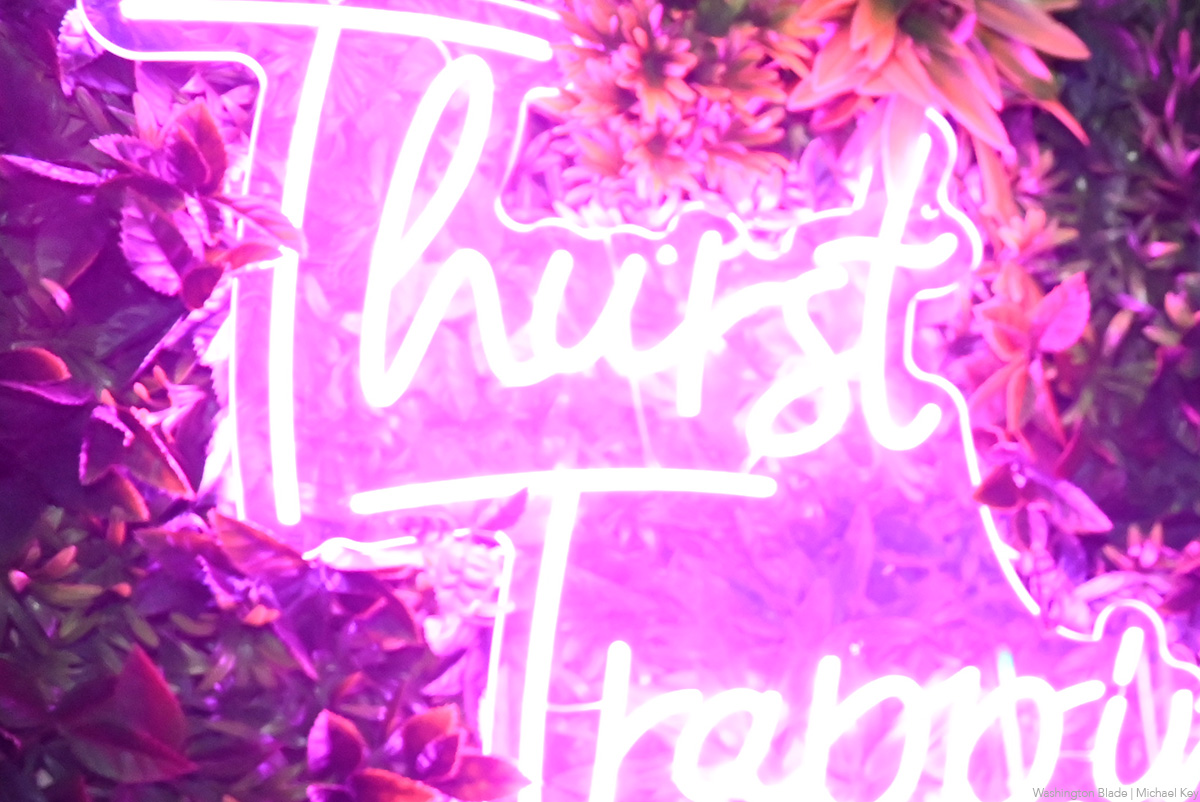
Impulse Group DC, a local advocacy organization, will host “Giving Tuesday and Happy Hour” on Tuesday, Dec. 2 at 6 p.m. at Thurst Lounge.
This event is a special happy hour fundraiser filled with good vibes, great food, and community connection. DJ Obie will be on deck keeping the energy high while you enjoy tacos, cocktails, and the kind of atmosphere only Thurst can deliver.
A portion of every signature cocktail sold goes directly toward supporting Impulse Group D.C.’s work in sexual health, mental health, harm reduction, and social justice for the D.C. community.
Admission is free and more details are available on Eventbrite.

Friday, November 28
“Center Aging Friday Tea Time” will be at 12 p.m. in person at the DC Center for the LGBT Community’s new location at 1827 Wiltberger St., N.W. To RSVP, visit the DC Center’s website or email [email protected].
Go Gay DC will host “LGBTQ+ Community Happy Hour” at 7 p.m. at Dupont Italian Kitchen Bar. This event is ideal for making new friends, professional networking, idea-sharing, and community building. This event is free and more details are available on Eventbrite.
Saturday, November 29
Go Gay DC will host “LGBTQ+ Community Brunch” at 12 p.m. at Freddie’s Beach Bar & Restaurant. This fun weekly event brings the DMV area LGBTQ+ community, including allies, together for delicious food and conversation. Attendance is free and more details are available on Eventbrite.
Sunday, November 30
Go Gay DC will host “LGBTQ+ Coffee and Conversation” at 12 p.m. at As You Are. Guests are encouraged to come and enjoy stimulating conversation. For more details, visit Eventbrite.
Monday, December 1
“Center Aging: Monday Coffee Klatch” will be at 10 a.m. on Zoom. This is a social hour for older LGBTQ adults. Guests are encouraged to bring a beverage of choice. For more information, contact Adam ([email protected]).
“Soulfully Queer: LGBTQ+ Emotional Health and Spirituality Drop-In” will be at 3 p.m. at the DC Center for the LGBT Community. This group will meet weekly for eight weeks, providing a series of drop-in sessions designed to offer a safe, welcoming space for open and respectful conversation. Each session invites participants to explore themes of spirituality, identity, and belonging at their own pace, whether they attend regularly or drop in occasionally. For more details visit the DC Center’s website.
Tuesday, December 2
Universal Pride Meeting will be at 7 p.m. on Zoom. This group seeks to support, educate, empower, and create change for people with disabilities. Email [email protected] with any questions.
Friends of Dorothy Cafe will host “Choose Our Blend” at 6 p.m. at Stardust Vintage & Gift. Guests are encouraged to come sip, sample, and vote on a lineup of custom coffee blends from Rustic Route Coffee Co., a DMV-based queer-owned roaster. Guests’ votes will help Rustic Route choose the café’s official signature roast. Event organizers will take donations, and more details are available on Eventbrite.
Wednesday, December 3
Job Club will be at 6 p.m. on Zoom. This is a weekly job support program to help job entrants and seekers, including the long-term unemployed, improve self-confidence, motivation, resilience and productivity for effective job searches and networking — allowing participants to move away from being merely “applicants” toward being “candidates.” For more information, email [email protected] or visit www.thedccenter.org/careers.
Center Aging Women’s Social Discussion Group will be at 7 p.m. on Zoom. This group is a place where older LGBTQ women can meet and socialize with one another. There will be discussion, activities, and a chance for guests to share what they want future events to include. For more details, email [email protected].
Thursday, December 4
The DC Center’s Fresh Produce Program will be held all day at the DC Center for the LGBT Community. People will be informed on Wednesday at 5 p.m. if they are picked to receive a produce box. No proof of residency or income is required. For more information, email [email protected] or call 202-682-2245.
Virtual Yoga Class will be at 7 p.m. on Zoom. This is a free weekly class focusing on yoga, breathwork, and meditation. For more details, visit the DC Center for the LGBT Community’s website.
API Queer Support Group will be at 7 p.m. on Zoom. This is a support group for the Asian and Pacific Islander Queer Community. For more details, email [email protected].
Theater
D.C. theater scene has something for everyone this holiday season
‘Nutcracker,’ ‘A Christmas Carol,’ and much more
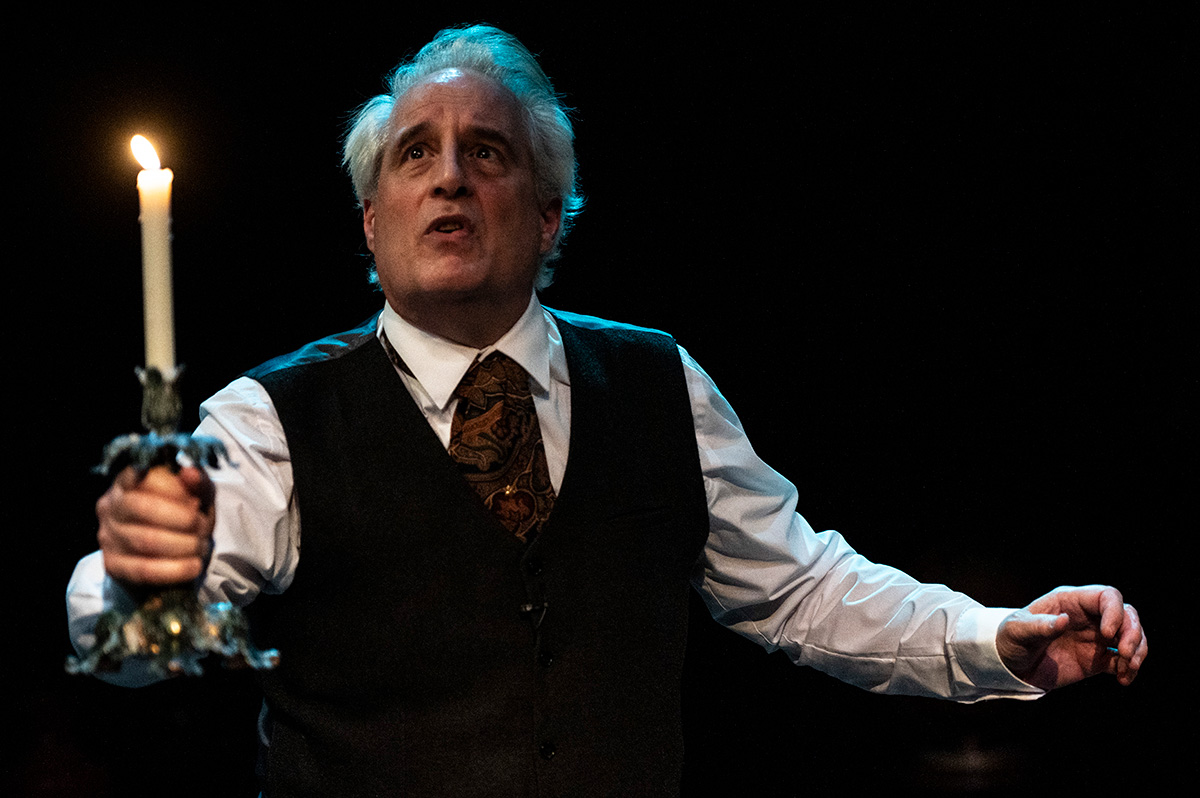
With its familiar music, yuletide imagery, and storytelling, theater can be a big part of the holidays. Add to that making memories and theater tickets wrapped as presents under the tree, and it’s a seasonal no brainer.
Folger Theatre presents “Resplendent Joy: Christmas Traditions from Spain and Portugal” (Dec. 5-14); the marvelous Folger Consort will perform early Spanish Christmas carols and traditional holiday music from early modern Spain and Portugal: folger.edu/resplendent
At Round House Theatre, playwright Sam Holcroft’s “Rules for Living” (Dec. 3-Jan. 4) makes its U.S. premiere. The darkly funny holiday comedy was a hit in London and is now hoping to repeat that success with a version tailored for the states. The seven-person cast includes versatile actors Naomi Jacobson and real-life spouse John Lescault. Ryan Rillette directs. roundhousetheatre.org
Theatre J presents “Chanukah in the Dark” (Dec. 6-21), an hour-long play ideal for ages five and up. “When the lights go out during Chanukah, Max and family begin sharing songs, stories, and traditions — only to discover the lights they needed and the miracles they searched for were in their midst all along.” edcjcc.org
The Cathedral Choral Society’s “Joy of Christmas” (Dec. 13-14) presents a wonderful program of carols and beloved holiday favorites at the festively decorated National Cathedral. The program features Seraph Brass, organist Edward Hewes, Carillonneur Edward M. Nassor, percussionist Mary La Blanc of “The President’s Own” U.S. Marine Band, and the Eastern Concert Choir from Eastern Senior High School. Cathedralchoralsociety.org
With “The Holiday Show,” (Dec. 13, 14, and 20), the Gay Men’s Chorus returns to entertain audiences with its annual and most popular show.
This year the holiday extravaganza is bigger than ever at historic Lincoln Theatre with new, soulful arrangements of favorite holiday carols: “The reindeer will be high-kicking and the snowflakes will sparkle. Songs include “O Holy Night,” “Rudolph the Red Nosed Reindeer,” “Let It Snow,” “We Wish You the Merriest,” and “Go Tell It on the Mountain.’” gmcw.org
At Olney’s intimate Mulitz-Gudelsky Theatre Lab, out actor Michael Russotto is back for the holiday season in his solo show “Christmas Carol: A Ghost Story of Christmas” (through Dec. 28). The talented Russotto portrays nearly 50 different characters from the Charles Dickens classic, that proves “funnier and far more relevant than you might imagine.” Olneytheatre.org
Also on holiday offer in the DMV are a jolly bunch of musical chestnuts as well as reliable Christmas crowd-pleasers.
Included on the roster is Olney Theatre’s production of Jerry Herman’s “Hello, Dolly!” (through Jan. 4) starring the mega-talented Nova Y. Payton. Based on the play “The Matchmaker” by famed gay playwright Thornton Wilder, the musical has proved a vehicle for many a diva including Carol Channing, Pearl Bailey, Bette Midler, and Barbra Streisand. Now Payton dons the mantle and the buzz is good.
Another beloved musical is “Fiddler on the Roof” (through Jan. 25), the story of Tevye, a poor Jewish milkman, his family and their tight-knit community who honor tradition while contending with pogroms in Czarist Russia. Currently being performed intimately in the round at Signature Theatre in Arlington and directed by Joe Calarco, the large cast features actors Douglas Sills, Chrisopher Bloch, and terrific out actor Jake Loewenthal as the poor tailor Motel Kamzoil, all singing Broadway favorites like “Sunrise, Sunset” “If I Were a Rich Man” and “Matchmaker.” sigtheatre.org
At Shakespeare Theatre Company’s Harman Hall is Frank Loesser’s “Guys and Dolls” (through Jan. 4). Based on tales from famed American journalist Damon Runyon, the show focuses on two overlapping love stories set in Depression-era Times Square. The terrific score includes songs like “Luck Be a Lady,” “Sit Down, You’re Rockin’ the Boat,” “A Bushel and a Peck,” and more songs you’ll know. Directed by Francesca Zambello and choreographed by Joshua Bergasse.
The cast includes Julie Benko, Lamont Brown, and Holly Twyford as General Matilda B. Cartwright, which is reason enough to buy a ticket. shakespearetheatre.org
And for hardcore traditionalists there’s the Washington Ballet’s “The Nutcracker” (through Dec. 29) with its balletic magic at the charming gilded Warner Theatre. The beloved production of Tchaikovsky’s ballet, here set in 1882 Georgetown, features a retinue of agile partiers, children, soldiers, rats, and notable figures from American history. washingtonballet.org
And last but hardly least, historic Ford’s Theatre presents “A Christmas Carol” (through Dec. 31), an enduring Washington tradition since I was youngish. Conceived by Michael Baron, this charming Dickens’ moneymaker again spotlights Craig Wallace as miserly Ebenezer Scrooge who after a night of ghostly visits, rediscovers Christmas joy. Fords.org
-

 District of Columbia3 days ago
District of Columbia3 days agoBowser announces she will not seek fourth term as mayor
-

 U.S. Military/Pentagon3 days ago
U.S. Military/Pentagon3 days agoPentagon moves to break with Boy Scouts over LGBTQ and gender inclusion
-

 Drag3 days ago
Drag3 days agoPattie Gonia calls out Hegseth’s anti-LGBTQ policies — while doing better pull-ups
-

 District of Columbia4 days ago
District of Columbia4 days agoSecond gay candidate announces run for Ward 1 D.C. Council seat

